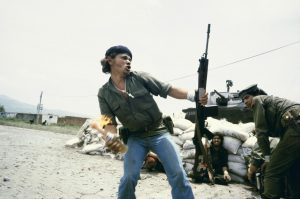These are two highly informative documentaries about the Nicaraguan revolution, the involvement by the United States, and coverage of the events by big media. The documentaries offer in-depth analysis on the implications of altering the portrayal of real events in mainstream media. The major news outlets in the United States followed an agenda that many argue was to the detriment of the Nicaraguan people. The media bosses cared about their networks’ ratings, not the actual portrayal or the truth
The World Is Watching reveals the media coverage during the conflict and the World Stopped Watching is fifteen years later as members of the original crew return to Nicaragua and follows up with some of the individuals they had covered in the original documentary. The first documentary conveys its main point through on-the-ground experiences in Nicaragua contrasted with actions of the media bosses in New York City. There are many shots of reporters going into a village and capturing anything that might be of interesting for their newsreel later on. The film also shows some of the exchanges between the journalists in Nicaragua and the media bosses in New York.
The most moving moments of both films were the emotional interviews with Nicaraguans. They were personal and moving, the types of interviews the videographers were after at the time. These interviews are a powerful method to gain insight into the person’s life that ultimately provides perspective and cross-cultural understanding.
The general tone of the film was fairly critical of US foreign policy. The producers of these documentaries were also definitely critical of the way TV networks put ratings above the actual portrayal of truth. It might not have seemed like it at the time, but this had serious consequences for the lives of Nicaraguans. World opinion on the events influences what unfolds on the ground and an inaccurate portrayal can have serious implications.
Overall, the documentaries got their point across quite well. Through the firsthand video of the reporters, journalists, editors, politicians, and Nicaraguan people we see a personal perspective of what was going on. These films show just how much influence the US media had on the world’s perception. The personal stories stir the emotions of the viewers and make them sympathetic to the plight of the Nicaraguan people and the difficulties they faced getting the truth of their country out to the rest of the world.
